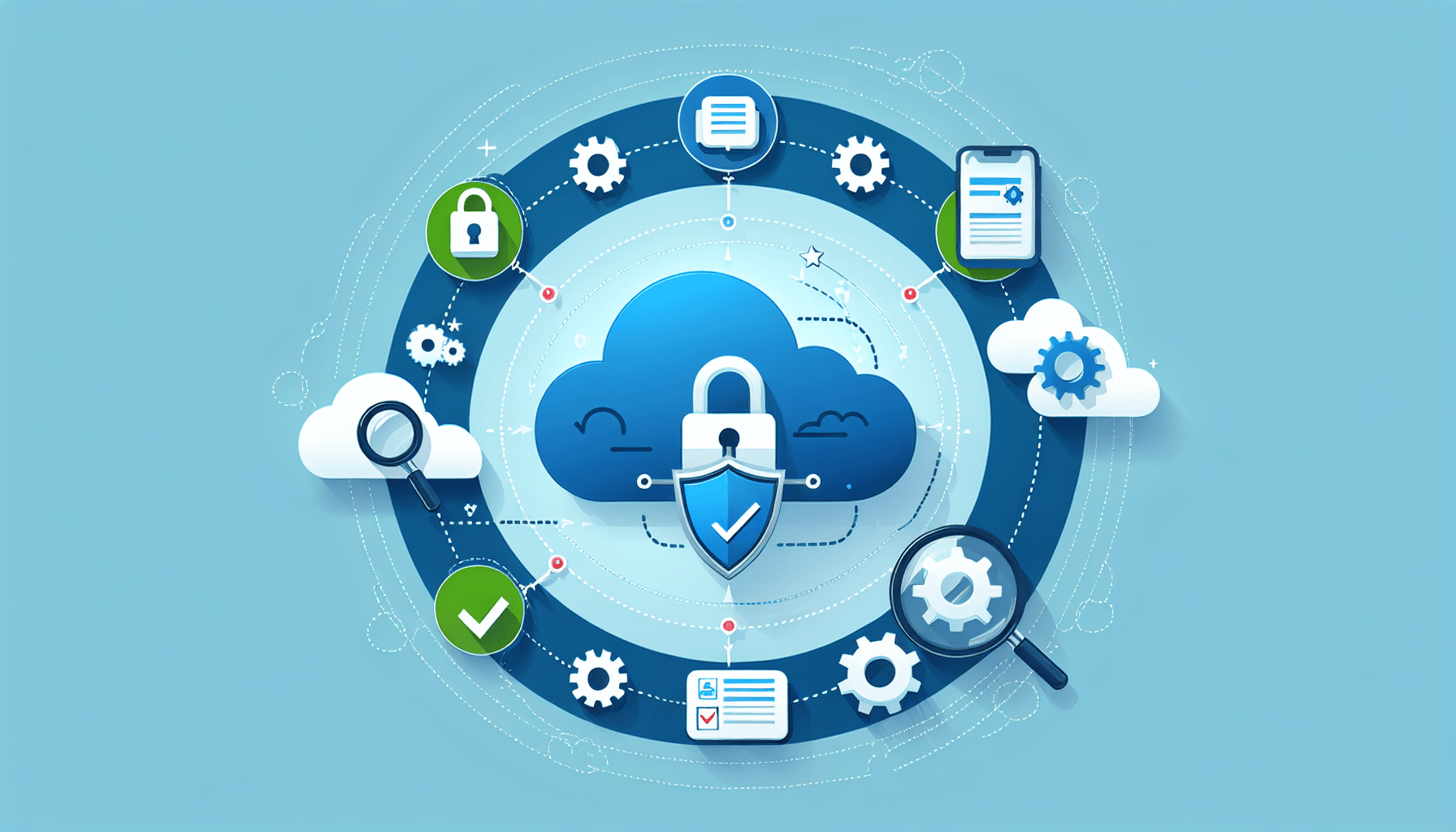Cloud Security Assessments: Addressing Emerging Threats and Risks is an insightful article that explores the critical importance of comprehensive evaluations in ensuring the security of cloud systems. As organizations increasingly rely on the cloud to store and process sensitive data, they face an escalating array of potential threats and risks. This article sheds light on the significance of regularly assessing the security landscape and implementing appropriate strategies to fortify cloud infrastructure against malicious attacks, data breaches, and privacy infringements. By adopting a proactive approach towards cloud security assessments, businesses can effectively safeguard their assets, maintain trust with customers, and mitigate the potential damage caused by emerging threats in a rapidly evolving digital landscape.

Understanding Cloud Security Assessments
Definition of cloud security assessments
Cloud security assessments are a systematic evaluation and analysis of the security measures and vulnerabilities present in cloud computing environments. These assessments help organizations identify and address potential threats and risks associated with storing and accessing data in the cloud. By evaluating the effectiveness of security controls, access controls, encryption practices, and security policies and procedures, cloud security assessments provide insights into weaknesses that could be exploited by cyber attackers.
Importance of cloud security assessments
Cloud security assessments play a crucial role in today’s digital landscape, where cloud computing has become a cornerstone of business operations. As organizations increasingly rely on the cloud to store and process sensitive data, it becomes imperative to ensure that adequate security measures are in place. Cloud security assessments provide a proactive approach to identifying and mitigating vulnerabilities, thus reducing the risk of data breaches, financial losses, and reputational damage. By understanding the importance of cloud security assessments, organizations can prioritize the protection of their assets and maintain customer trust.
Common goals of cloud security assessments
Cloud security assessments typically aim to achieve the following objectives:
- Identify vulnerabilities and weaknesses in the cloud infrastructure and applications.
- Evaluate access controls and permissions to ensure appropriate levels of authorization and authentication.
- Assess data encryption and protection practices to safeguard sensitive information.
- Evaluate the effectiveness of security policies and procedures to ensure compliance with industry standards and regulations.
- Determine the overall security posture of the cloud environment and provide recommendations for improvement.
Emerging Threats to Cloud Security
Overview of emerging threats in cloud security
As the adoption of cloud computing continues to grow, so do the threats and risks associated with it. Organizations are faced with a constantly evolving threat landscape that requires them to stay vigilant and adapt their security measures accordingly. Some of the emerging threats in cloud security include:
- Malware and ransomware attacks targeting cloud infrastructure and applications.
- Insider threats, where employees or trusted individuals intentionally or unintentionally compromise cloud security.
- Data breaches resulting from misconfigurations or weak access controls.
- Denial of Service (DoS) and Distributed Denial of Service (DDoS) attacks aimed at disrupting cloud services.
- Cloud-specific vulnerabilities and exploits, such as container vulnerabilities or orchestration misconfigurations.
Types of cyber threats in the cloud
Cloud computing introduces new avenues for cyber threats. Some of the common types of cyber threats in the cloud include:
- Data breaches: Unauthorized access to sensitive data stored in the cloud, leading to potential financial or reputational damage.
- Account hijacking: Unauthorized access to user accounts or administrative privileges, allowing attackers to control cloud resources.
- Data loss: Accidental or intentional deletion, corruption, or theft of data stored in the cloud.
- Malware and ransomware attacks: Infection of cloud resources with malicious software, resulting in data loss or extortion attempts.
- Insider threats: Malicious or negligent actions by employees or trusted individuals that compromise cloud security.
Impact of emerging threats on organizations
The consequences of falling victim to emerging threats in cloud security can be severe for organizations. These threats can result in financial losses, damage to the organization’s reputation, legal and regulatory compliance issues, and compromised customer trust. Organizations may also face operational disruptions and loss of productivity. It is, therefore, crucial for organizations to continually assess and address these emerging threats to safeguard their digital assets and maintain business continuity.
Key Components of Cloud Security Assessments
Identifying and assessing vulnerabilities
One of the key components of a cloud security assessment is the identification and assessment of vulnerabilities within the cloud environment. This involves conducting vulnerability scans and penetration tests to uncover weaknesses that could be exploited by malicious actors. By understanding the vulnerabilities present in the cloud infrastructure, applications, and configurations, organizations can prioritize remediation efforts and reduce the risk of successful cyberattacks.
Evaluating access controls and permissions
Access controls and permissions play a critical role in maintaining the integrity and confidentiality of data stored in the cloud. During a cloud security assessment, it is essential to evaluate the effectiveness of access controls and permissions in place. This involves reviewing user access policies, authentication mechanisms, and authorization processes. By ensuring that only authorized individuals have access to sensitive data, organizations minimize the risk of unauthorized access and data breaches.
Assessing data encryption and protection
Data encryption is a vital component of cloud security assessments. Organizations need to assess the encryption methods used for data protection, both at rest and in transit within the cloud environment. This includes evaluating the strength of encryption algorithms, key management practices, and encryption protocols. Robust encryption ensures that even if an attacker gains unauthorized access to the data, it remains encrypted and unreadable without appropriate decryption keys.
Evaluating the effectiveness of security policies and procedures
The effectiveness of security policies and procedures is pivotal in maintaining a secure cloud environment. During a cloud security assessment, organizations evaluate the adequacy and implementation of their security policies, incident response plans, and disaster recovery processes. Regular reviews and updates of these policies and procedures help ensure that they remain in line with industry best practices and evolving threat landscapes.
Best Practices for Cloud Security Assessments
Establishing a comprehensive security framework
To conduct effective cloud security assessments, organizations should establish a comprehensive security framework that serves as a guide for evaluating and improving security measures. This framework should include standardized procedures, checklists, and guidelines for assessing various aspects of cloud security, such as vulnerability management, access controls, data protection, and incident response. By having a defined security framework in place, organizations can ensure consistency and thoroughness in their assessments.
Implementing strong access controls
Access controls form a critical layer of defense in cloud security. It is essential for organizations to implement strong access controls, including multi-factor authentication, strong password policies, and role-based access controls. By limiting access to only those individuals who require it, organizations reduce the risk of unauthorized access and insider threats. Regular audits of access controls and permissions are necessary to ensure their effectiveness.
Regularly monitoring and updating security measures
Cloud security is a dynamic process, and organizations must continuously monitor and update their security measures to address new threats and vulnerabilities. Regular vulnerability scans, intrusion detection systems, and log analysis help organizations identify and respond to security incidents promptly. Additionally, organizations should stay informed about emerging security trends, best practices, and industry-specific regulations to adapt their security measures accordingly.
Conducting periodic penetration testing
Penetration testing, also known as ethical hacking, is a proactive approach to assessing the security of a cloud environment. By simulating real-world cyberattacks, organizations can identify weaknesses and vulnerabilities that may be overlooked during regular security assessments. Conducting periodic, well-planned penetration tests assists in uncovering critical vulnerabilities and verifying the effectiveness of security controls.

Benefits of Cloud Security Assessments
Improved protection against cyber threats
By conducting regular cloud security assessments, organizations significantly improve their ability to detect and mitigate emerging threats. By identifying vulnerabilities and weaknesses, organizations can promptly remediate them, reducing the risk of successful cyberattacks. This proactive approach to security ensures that organizations stay one step ahead of potential threats, enhancing their overall cyber resilience.
Enhanced compliance with regulations and standards
Cloud security assessments help organizations align their security practices with industry-specific regulations and standards. By conducting assessments and implementing necessary security controls, organizations can ensure compliance with regulations such as the General Data Protection Regulation (GDPR), the Health Insurance Portability and Accountability Act (HIPAA), and the Payment Card Industry Data Security Standard (PCI DSS). Compliance not only helps organizations avoid legal and financial penalties but also demonstrates a commitment to safeguarding customer data.
Increased trust and confidence among stakeholders
By conducting cloud security assessments, organizations demonstrate their commitment to protecting sensitive data and safeguarding the interests of their stakeholders. Whether they are customers, partners, or shareholders, stakeholders gain confidence in the organization’s ability to secure their information and maintain business continuity. Increased trust and confidence can have positive effects on the organization’s reputation, leading to strengthened relationships and potential business opportunities.
Reduced risk of data breaches and financial losses
The primary goal of cloud security assessments is to identify and address vulnerabilities that could lead to data breaches and financial losses. By proactively assessing security measures, organizations can reduce the likelihood of successful cyberattacks and mitigate the potential impact. By implementing appropriate security controls, organizations can protect their valuable assets, minimize the risk of data breaches, and avoid the financial and reputational consequences that accompany them.
Challenges in Conducting Cloud Security Assessments
Complexity of cloud environments
Cloud computing environments are inherently complex, involving various interconnected components and dependencies. Assessing the security of these environments requires a deep understanding of cloud technologies, architectures, and protocols. The complexity of cloud environments can pose challenges for organizations aiming to conduct thorough and accurate security assessments. It requires expertise and specialized knowledge to navigate and assess the unique security risks associated with the cloud.
Lack of expertise and resources
Another challenge organizations face in conducting cloud security assessments is the lack of expertise and resources. Assessing the security of cloud environments requires skilled professionals who understand the nuances of cloud computing, along with the ability to perform vulnerability scans, penetration tests, and security audits. However, many organizations may not have dedicated security teams or individuals with the necessary skills or resources to effectively conduct these assessments.
Integration with existing security tools and processes
Integrating cloud security assessments with existing security tools and processes can be challenging for organizations. Cloud environments often require specialized security solutions and platforms that may not be easily compatible with the organization’s existing infrastructure. Ensuring seamless integration and collaboration between different security tools and platforms is crucial for organizations to effectively assess and mitigate cloud security risks.
Adapting to evolving security threats
The landscape of cybersecurity is constantly evolving, with new threats, vulnerabilities, and attack techniques emerging regularly. Organizations face the challenge of keeping up with these evolving threats and adapting their security assessments accordingly. It requires continuous learning, staying informed about the latest security trends, and actively seeking ways to enhance security measures to address new and emerging threats effectively.
Steps to Conduct a Cloud Security Assessment
Defining assessment objectives and scope
The first step in conducting a cloud security assessment is to define the assessment objectives and scope. This involves identifying the specific goals and areas of focus for the assessment, such as evaluating access controls, identifying vulnerabilities, or assessing data protection practices. Clearly defining the scope helps ensure that the assessment remains focused and comprehensive.
Identifying relevant cloud security controls
After defining the assessment objectives and scope, the next step is to identify the relevant cloud security controls to assess. This includes understanding the cloud architecture, service models (Software as a Service, Platform as a Service, Infrastructure as a Service), and associated security controls. Different types of cloud environments may require different assessment approaches and consideration of specific security controls.
Collecting and analyzing security-related data
The assessment process involves collecting and analyzing security-related data from the cloud environment. This can include reviewing security policies, configuration settings, access logs, incident response plans, and other relevant documentation. Collecting and analyzing this data provides insights into the state of security measures, identifies potential vulnerabilities, and helps organizations make informed decisions regarding remediation efforts.
Conducting vulnerability scans and penetration tests
Vulnerability scans and penetration tests are critical components of cloud security assessments. Vulnerability scanning tools help organizations identify known vulnerabilities within their cloud environment, while penetration tests simulate real-world attacks to uncover potential weaknesses and vulnerabilities. Both of these techniques provide valuable insights into the security of the cloud environment and help organizations prioritize mitigation efforts.
Documenting findings and recommendations
Once the assessment is complete, it is essential to document the findings and recommendations. This includes compiling a comprehensive report that outlines the identified vulnerabilities, weaknesses, and areas for improvement. The report should provide clear and actionable recommendations for remediation, along with any necessary timelines or priorities. Documentation facilitates communication with stakeholders and serves as a reference for future assessments and improvements.
Tools and Technologies for Cloud Security Assessments
Cloud security assessment platforms
Cloud security assessment platforms are designed to assist organizations in evaluating the security of their cloud environments. These platforms provide a centralized interface for vulnerability management, compliance monitoring, and security configuration assessment. They enable organizations to automate security assessments, streamline processes, and gain actionable insights to strengthen their cloud security posture.
Vulnerability scanning tools
Vulnerability scanning tools automate the process of identifying potential vulnerabilities within the cloud environment. These tools scan systems, networks, and applications to identify known vulnerabilities, misconfigurations, and security weaknesses. Organizations can leverage vulnerability scanning tools to detect weaknesses that attackers could exploit and prioritize remediation efforts accordingly.
Intrusion detection systems
Intrusion detection systems (IDS) help organizations detect and respond to potential security incidents within their cloud environment. IDS monitor network traffic, log files, and system activities to identify suspicious or malicious behavior. By leveraging IDS, organizations can detect unauthorized access attempts, anomalous activities, and potential security breaches, allowing for timely incident response and remediation.
Data loss prevention solutions
Data loss prevention (DLP) solutions help organizations protect sensitive data from being lost, stolen, or compromised within the cloud environment. DLP solutions typically involve the use of data classification, encryption, and policy-based controls to prevent unauthorized access and ensure data integrity. By implementing DLP solutions, organizations can better protect their sensitive data and prevent data breaches or accidental data loss.
Compliance Considerations for Cloud Security Assessments
Understanding industry-specific regulations and standards
Cloud security assessments must take into consideration industry-specific regulations and standards that govern the protection of sensitive data. For example, organizations operating in the healthcare industry must comply with the Health Insurance Portability and Accountability Act (HIPAA), while those handling payment card information must adhere to the Payment Card Industry Data Security Standard (PCI DSS). Understanding these regulatory requirements helps organizations tailor their security assessments to meet compliance obligations.
Ensuring compliance with data protection laws
Data protection laws, such as the General Data Protection Regulation (GDPR), place specific obligations on organizations regarding the processing and protection of personal data. Cloud security assessments should take into account the requirements outlined by these data protection laws, such as obtaining informed consent, implementing appropriate security measures, and ensuring data subjects’ rights are respected. Compliance with data protection laws helps organizations avoid legal and financial penalties and reinforces customer trust.
Addressing privacy concerns and GDPR requirements
Privacy concerns are a significant consideration in cloud security assessments, especially with the implementation of data protection regulations like the GDPR. Assessments should evaluate the organization’s privacy practices, data handling procedures, and adherence to privacy principles. Organizations need to ensure that personal data is collected, stored, and processed in a manner that respects individuals’ privacy rights and meets legal requirements.
Continuous Improvement and Adaptation
Establishing a culture of security awareness
In addition to conducting regular cloud security assessments, organizations should strive to establish a culture of security awareness. This involves educating employees about the importance of security, promoting best practices, and providing ongoing training to address emerging threats. By fostering a security-conscious culture, organizations ensure that security practices become ingrained in day-to-day operations and that employees actively contribute to the protection of sensitive data.
Regularly updating security measures
Cloud security is not a one-time effort but requires continuous monitoring and updating of security measures. Organizations should regularly review and update their security policies, procedures, and controls to address new threats and vulnerabilities. This includes staying informed about emerging security trends, applying patches and updates promptly, and adapting security measures to align with evolving best practices.
Staying informed about emerging threats and vulnerabilities
To effectively address emerging security threats, organizations must stay informed about the latest trends and vulnerabilities. This involves monitoring cybersecurity news, participating in industry forums and conferences, and actively seeking information and resources from trusted sources. By staying informed, organizations can promptly respond to emerging threats, update their security measures, and continuously improve their security posture.
Collaborating with cloud service providers for security enhancements
Cloud service providers (CSPs) play a critical role in ensuring the security of cloud environments. Organizations should collaborate closely with their CSPs to enhance cloud security measures. This involves discussing security requirements, seeking clarification on security practices, and actively engaging in security-related discussions. Collaboration with CSPs helps organizations leverage the expertise and resources of their service providers to strengthen their overall cloud security.
In conclusion, cloud security assessments are essential for organizations operating in the cloud to address emerging threats and risks. By understanding the definition of cloud security assessments, the importance of conducting them, and the common goals associated with such assessments, organizations can prioritize the protection of their cloud environments. Key components such as identifying vulnerabilities, evaluating access controls, assessing data encryption, and evaluating the effectiveness of security policies contribute to a comprehensive cloud security assessment. By following best practices, organizations can enhance their cloud security posture, reap the benefits of improved protection and compliance, and minimize the risk of data breaches and financial losses. However, challenges such as the complexity of cloud environments, lack of expertise, and integration issues need to be overcome to conduct effective cloud security assessments. By following the steps outlined and leveraging tools and technologies available, organizations can conduct thorough cloud security assessments. Compliance considerations, such as understanding industry-specific regulations and data protection laws, further strengthen the assessment process. Continuous improvement, staying informed about emerging threats, and collaborating with CSPs play a vital role in ensuring the effectiveness of cloud security assessments and adapting to evolving security challenges.



